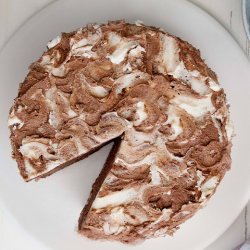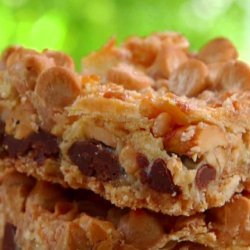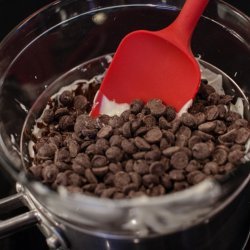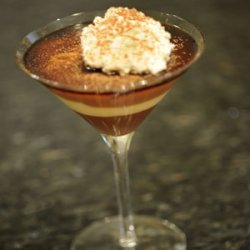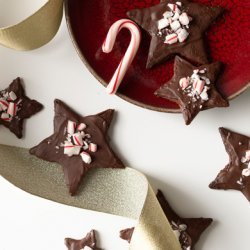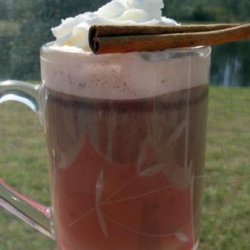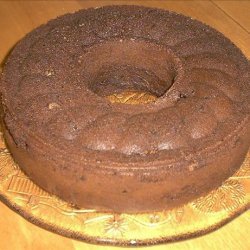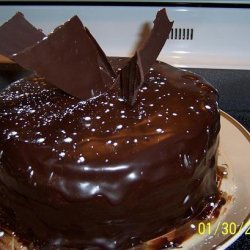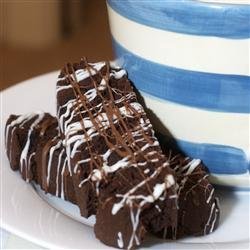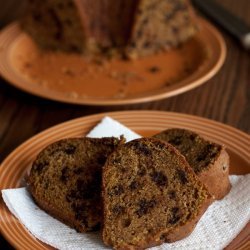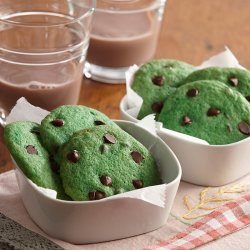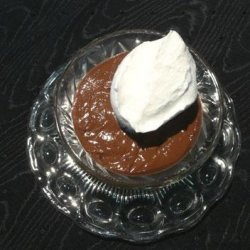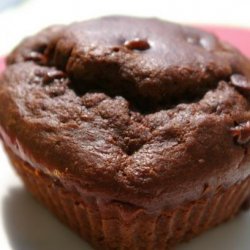Directions:
- For the Base: Place a piece of the bubble wrap, bubble side up, on your work surface. Using a large spoon or ladle, randomly drizzle white and bittersweet chocolate onto the plastic. Using an offset spatula, spread the two drizzled chocolates evenly, creating a marbled effect. You can make the base whatever size and shape you'd like it to be, however make sure it is at least 1/4-inch thick. Place in the refrigerator.
- For the Fish Mold: If you would like your chocolate fish to be painted on the outside, start by mixing together a few tablespoons of the cocoa butter with a small amount of powdered food coloring, making as many colors as you'd like. (Please note: The easiest way to work with chocolate paints is to store them in a yogurt machine to keep them warm.) Using a paintbrush, paint the inside of the mold, applying color wherever you are inspired to do so (eyes, fins, etc.) and let dry. Using a ladle, fill the fish mold or shell with white chocolate. When it is full, empty the excess chocolate back into the bowl. The inside of the mold should be evenly coated with chocolate. Wipe the lip of the mold clean, and place it upside down on a wire rack over a baking sheet. Once the chocolate starts to harden, about 5 minutes, scrape the lip clean again with a paring knife. This is very important because once the chocolate sets, it will shrink or retract from the sides of the mold, and a clean edge will prevent it from sticking and cracking as it shrinks. You can place the mold in the refrigerator for several minutes to help the chocolate to harden. Once the chocolate has hardened, remove it from the mold, glue the two halves together with chocolate and let harden. Repeat with as many fish molds or shells as you like.
- For the Seaweed and Sea Grass: Make 2 cornets and fill 1 with bittersweet chocolate and the other with white chocolate. Draw some seaweed onto parchment paper using bittersweet chocolate then repeat the same technique with the white chocolate, painting over the bittersweet. Use this same technique to draw sea grass. When the chocolate sets, peel off the parchment paper, and reserve for assembly.
- For the Coral: Place large ice cubes in a tall, round plastic container. Pour the untempered bittersweet chocolate over the cubes and let set until the cubes have completely melted. Remove the chocolate from the container, drain off, and discard the excess water.
- For the Final Seascape: Arrange the pieces as you would like on the bubble wrap base and glue them down using the melted chocolate. If you place all of the pieces in the refrigerator first, the sculpture will set faster, as the cold chocolate will cause the glue to harden and set quickly.
- How to Temper Chocolate(From Dessert Circus, Extraordinary Desserts You Can Make At Home by Jacques Torres):
- Chocolate is tempered so that after it has been melted, it retains its gloss and hardens again without becoming chalky and white (that happens when the molecules of fat separate and form on top of the chocolate). There are a variety of ways to temper.
- One of the easiest ways to temper chocolate is to chop it into small pieces and then place it in the microwave for 30 seconds at a time on high power until most of the chocolate is melted. Be very careful not to overheat it. (The temperature of dark chocolate should be between 88 and 90 degrees F, slightly warmer than your bottom lip. It will retain its shape even when mostly melted. White and milk chocolates melt at a temperature approximately 2 degrees F less because of the amount of lactose they contain.) Any remaining lumps will melt in the chocolate's residual heat. Use an immersion blender or whisk to break up the lumps. Usually, chocolate begins to set, or crystallize, along the side of the bowl. As it sets, mix those crystals into the melted chocolate to temper it. A glass bowl retains heat well and keeps the chocolate tempered longer.
- Another way to temper chocolate is called seeding. In this method, add small pieces of unmelted chocolate to melted chocolate. The amount of unmelted chocolate to be added depends on the temperature of the melted chocolate, but is usually 1/4 of the total amount. It is easiest to use an immersion blender for this, or a whisk.
- The classic way to temper chocolate is called tabliering. Two thirds of the melted chocolate is poured onto a marble or another cold work surface. The chocolate is spread out and worked with a spatula until its temperature is approximately 81 degrees F. At this stage, it is thick and begins to set. This tempered chocolate is then added to the remaining non-tempered chocolate and mixed thoroughly until the mass has a completely uniform temperature. If the temperature is still too high, part of the chocolate is worked further on the cold surface until the correct temperature is reached. This is a lot of work, requires a lot of room, and makes a big mess.
- A simple method of checking tempering, is to apply a small quantity of chocolate to a piece of paper or to the point of a knife. If the chocolate has been correctly tempered, it will harden evenly and show a good gloss within a few minutes.
- How to Make a Cornet (From Dessert Circus, Extraordinary Desserts You Can Make At Home by Jacques Torres):
- The Cornet: A cornet is a small piping bag made from parchment paper. It is usually used to make fine decorations.
- Cut an 8 by 12 by 14 1/2-inch triangle from a sheet of parchment paper. Hold the middle of the long side of the triangle between two fingers of one hand. Take the tip of the triangle on the short, wide end and roll it toward the other tip of that same end while simultaneously pulling it in an upward motion. The tip of a cone will form where your thumb and finger hold it on the long side.
- Release your grip from the long side, so that you are now holding the two corners where they meet. The paper will already resemble a partially formed cone. Roll the remaining tail until it is completely rolled into a cone. There will be one point sticking up from the open end. Fold it inside toward the center, and crease the fold. Now you should have a cornet. To close the cornet once it has been filled, fold it away from the seam; this will keep the seam from opening. Use a pair of scissors or a sharp paring knife to cut an opening at the tip of the cornet to the desired size.
Nutrition Facts
| Amount Per 1 Serving | |||
| Calories | 12192.77 Kcal (51049 kJ) | ||
| Calories from fat | 5266.3 Kcal | ||
| % Daily Value* | |||
| Total Fat | 585.14g | 900% | |
|---|---|---|---|
| Cholesterol | 576.07mg | 192% | |
| Sodium | 2358.72mg | 98% | |
| Potassium | 2594.59mg | 55% | |
| Total Carbs | 1805.33g | 602% | |
| Sugars | 1533.17g | 6133% | |
| Dietary Fiber | 45.36g | 181% | |
| Protein | 122.47g | 245% | |
| Vitamin C | 9.1mg | 15% | |
| Iron | 22.7mg | 126% | |
| Calcium | 3347.6mg | 335% | |
| Amount Per 100 g | |||
| Calories | 384 Kcal (1608 kJ) | ||
| Calories from fat | 165.86 Kcal | ||
| % Daily Value* | |||
| Total Fat | 18.43g | 900% | |
|---|---|---|---|
| Cholesterol | 18.14mg | 192% | |
| Sodium | 74.29mg | 98% | |
| Potassium | 81.71mg | 55% | |
| Total Carbs | 56.86g | 602% | |
| Sugars | 48.29g | 6133% | |
| Dietary Fiber | 1.43g | 181% | |
| Protein | 3.86g | 245% | |
| Vitamin C | 0.3mg | 15% | |
| Iron | 0.7mg | 126% | |
| Calcium | 105.4mg | 335% | |
* Percent Daily Values are based on a 2000 calorie diet. Your daily values may be higher or lower depending on your calorie needs.
Find out how many calories should you eat.
Get Your Recipe of Health!
Follow RecipeOfHealth on Facebook!


